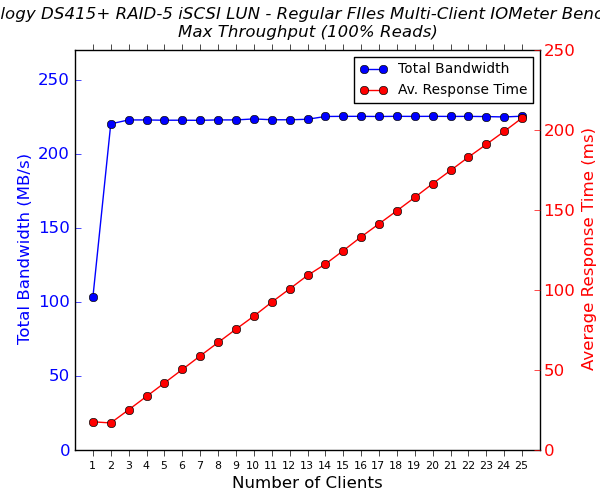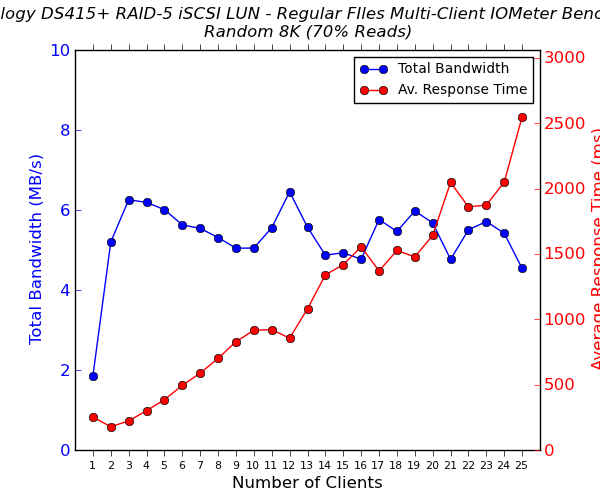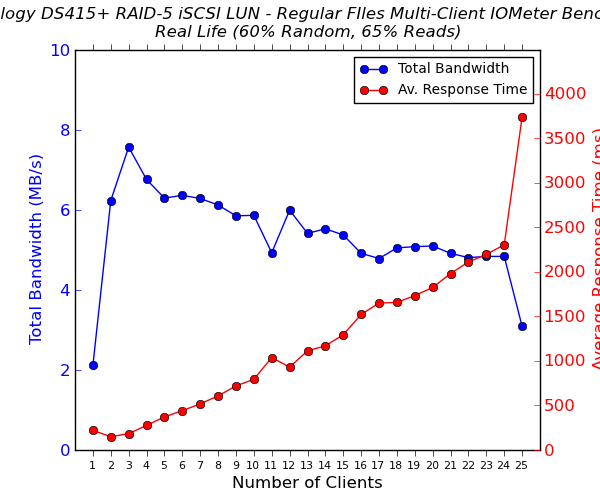Synology DS415+ Review: DSM on Intel Rangeley
by Ganesh T S on October 30, 2014 7:30 AM EST- Posted in
- NAS
- Storage
- Intel
- Synology
- Silvermont
- Enterprise
- Rangeley
Multi-Client iSCSI Evaluation
As virtualization becomes more and more popular even in home / power user settings, the importance of the iSCSI feature set of any COTS NAS can't be overstated. Starting with our ioSafe 1513+ review, we have started devoting a separate section (in the reviews of NAS units targeting SMBs and SMEs) to the evaluation of iSCSI performance. Since we have already looked at the way iSCSI LUNs are implemented in DSM in the ioSafe 1513+ review, it won't be discussed in detail.
We evaluated the performance of the DS415+ with file-based LUNs as well as configuring a RAID-5 disk group with a single LUN. The standard IOMeter benchmarks that we used for multi-client CIFS evaluation were utilized for iSCSI evaluation also. The main difference to note is that the CIFS evaluation was performed on a mounted network share, while the iSCSI evaluation was done on a 'clean physical disk' (from the viewpoint of the virtual machine).
Performance Numbers
The four IOMeter traces were run on the physical disk manifested by mapping the iSCSI target on each VM. The benchmarking started with one VM accessing the NAS. The number of VMs simultaneously playing out the trace was incremented one by one till we had all 25 VMs in the fray. Detailed listings of the IOMeter benchmark numbers (including IOPS and maximum response times) for each configuration are linked below:
- Synology DS415+ - iSCSI LUN (Regular Files) - 4x 4 TB / RAID-5 / 2x 1G
- Synology DS415+ - Single LUN on RAID - 4x 4 TB / RAID-5 / 2x 1G




Since the number of NAS units that we have put through this evaluation is limited, the only real point of comparison is the Seagate NAS Pro 4-bay. The ioSafe 1513+ graphs are also linked above, but it has five drives instead of the four in the DS415+. The only graphs for apples-to-apples comparison are those of the Seagate NAS Pro 4-bay units. We see advantages in terms of average access times for the Synology DS415+. This is only to be expected, given the faster clock for the Rangeley SoC in the DS415+.
As more NAS units are processed, we hope this section will provide readers with a way to quickly get an idea of the competitive performance of a particular NAS unit when it comes to iSCSI support.










41 Comments
View All Comments
DanNeely - Thursday, October 30, 2014 - link
It's US Gov Speak (if you follow the link it comes from US Govt Acquisition rules). I suspect it's less generally known than that it appears common in a casual search because US Gov/Contractors collectively represent millions of people.Laststop311 - Thursday, October 30, 2014 - link
Beast quad core cpu for a NAS.Morawka - Friday, October 31, 2014 - link
where is the ipad air 2 review. you guys even got early review units right? you went to the keynote.jabber - Friday, October 31, 2014 - link
When there are 4539 iPad Air 2 reviews all saying pretty much the same thing why bother? Why not review something else that enthusiasts might be interested in.iPads are for baby boomers and your mum and dad.
mexell - Friday, October 31, 2014 - link
RAID5 for drives this large is calling for trouble. Several enterprise vendors discourage usage of RAID5 for large 7.2k drives because the risk of a second-drive loss (or just effects of bit rot) during a rebuild is just too high.I am aware that both RAID6 and RAID10 in a four-bay unit mean 50% capacity loss compared to 25% for RAID5, but in the end, it's your personal media archive that's at risk.
So, a comparison of RAID10 and RAID6 speeds would have been nice.
skarnm2 - Friday, October 31, 2014 - link
I think you would go with 5+ disk versions for Raid 6.FalconX69 - Friday, October 31, 2014 - link
Can someone explain why I7 or xenon based Nas drives are so expensive when the chip is only a few hundred dollars more then these atoms? Wish symbology or qnap would allow custom nas units but with reasonable prices.RockyMcNuts - Tuesday, November 25, 2014 - link
You can put a Synology-compatible OS on custom hardware, or use an open source NAS OS like FreeNAS. At least if it's for a home project, not sure I would do this for a commercial project.http://us.hardware.info/reviews/5525/workshop-xpen...
http://www.avsforum.com/forum/39-networking-media-...
http://xpenology.com/forum/
sin_tax - Saturday, November 1, 2014 - link
Would the more powerful CPU allow this to be a suitable box for Plex Media Server? Can it handle transcoding one or more 1080p streams?asendra - Monday, November 3, 2014 - link
I would love to know the answer to this. I need a box that can handle Plex, only 1 stream, at 1080p.Currently I have my big gaming PC with PMS, but I prefer a low power NAS, or a HTPC+NAS with Plex/PMS.
Currently I'm debating between this or a custom box with a J1900 quad @ 2Ghz. Prefer the simplicity of Synology and how compact it is, but don't like the price and I'm not sure if it can handle it...